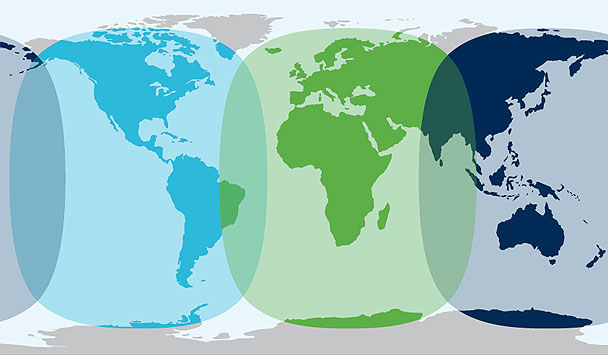Inmarsat's latest I4 satellite system, as used for BGAN and FleetBroadband, is the first to make possible the high speeds and flexibility of the Internet that you have come to expect in your home, from some of the worlds most remote places.
The Imarsat FleetBroadband series range from giving you 150Kbs up to an impressive 432Kbs. Although this is probably not as fast as your home Broadband connection, it has given an increasing number of business men, the opportunity to operate their business from anywhere on the planet.
With the release of the new FleetBroadband 150, Inmarsat have closed the gap between high speed data on-board and affordability, and made the versatility of the Internet available to a whole new class of boat owner.
Inmarsat I4 satellite system & coverage
The Inmarsat I4 satellite system uses four geostationary satellites to deliver its high speed data and voice communications. The advantage of the geostationary satellites is that they are in a fixed orbit 36,000KM over the Equator. This means that the antenna does not need to have a clear view of the whole sky, but only a narrow gap pointing directly at the satellite, possible between two buildings or a gap in the tree canopy.
However, because the satellites are in fixed orbits above the Equator there are some gaps in global coverage. There are two reasons for this.
- As the Earth curves away from the satellite towards the poles the satellite will appear lower and lower in the sky. This has the affect of increasing the footprint of a single spot beam, meaning that the signal is having to travel further and is less focused. The smaller terminals performance will be reduced or unavailable near the fringes of the coverage area.
- Eventually the curve of the earth will block the satellite form view entirely, resulting in the the gaps in coverage above the north and south poles. (see Inmarsat I4 coverage map opposite)
Inmarsat FleetBroadband & BGAN series compared
Sailor FleetBroadband 150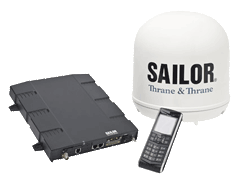 The Sailor FleetBroadband 150 closes the gap between affordability and Broadband on your boat. |
Sailor FleetBroadband 250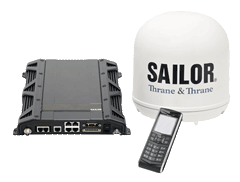 The Sailor FleetBroadband 250, the right balance between speed, size and money! |
Sailor FleetBroadband 500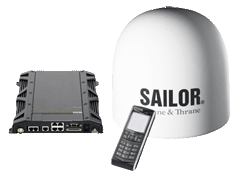 The Sailor FleetBroadband 500, the ultimate in on-board high speed Internet! |
Wideye Sabre 1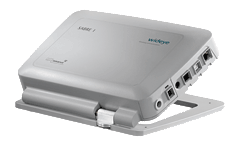 The Wideye Sabre 1 is a great entry level Inmarsat BGAN unit. |
Explorer 300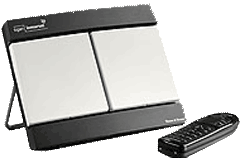 The Explorer 300 from Thrane & Thrane is the complete mobile broadband office at your finger tips |
Running Costs
The running costs are very simply for the FleetBroadband series. Inmarsat FleetBroadband are one of only a few satellite systems which can offer the option of very high speed "always-on broadband" style internet access, charged based on the data volume used (versus the time online). This is very similar to using "GPRS" on your mobile phone (except that your mobile phone doesn't work in the middle of an ocean).
You pay
- $12.29 per MB of Data ($1.53 per Mb)
- $1.37 per minute (voice calls)
The most complicated thing about the airtime pricing is working out what you can get done with a MB of data. As a general rule if you are using MailASail's Express mail compression, then text emails should go relatively unnoticed on your bill. You should be able to get in excess of 200 emails for your $12.29. Weather files are very expensive either. Using the our weather responder you can get an Atlantic sized grib file with 6 predictions for $1.
Browsing the web is a little harder to quantify. If you know where you are going and the site is well written, like BBC news pages, then it won't cost you very much. However it is not priced to browse youtube. There is a very handy tool that allows you to see how much data you are using so you can get an idea for the costs of browsing the web during your first few months of usage.
An important thing to be aware of, when paying for anything, is what you are paying for. Some people price things in Mega Bytes and others in Mega bits, usually depending on which one makes their system more appealing. They are easily confused but very different. A Byte is eight times bigger than a bit. If someone is referring to a Mega Byte they should use the abbreviation MB. Alternatively if they are referring to a Mega bit then they should use Mb.
Please contact MailASail for your free FleetBroadband sim card email: info@mailasail.com




